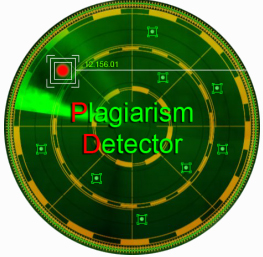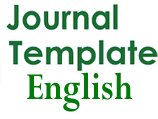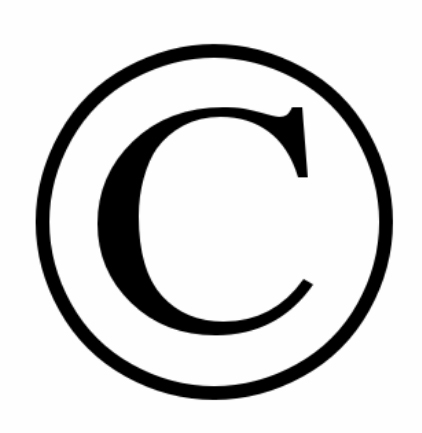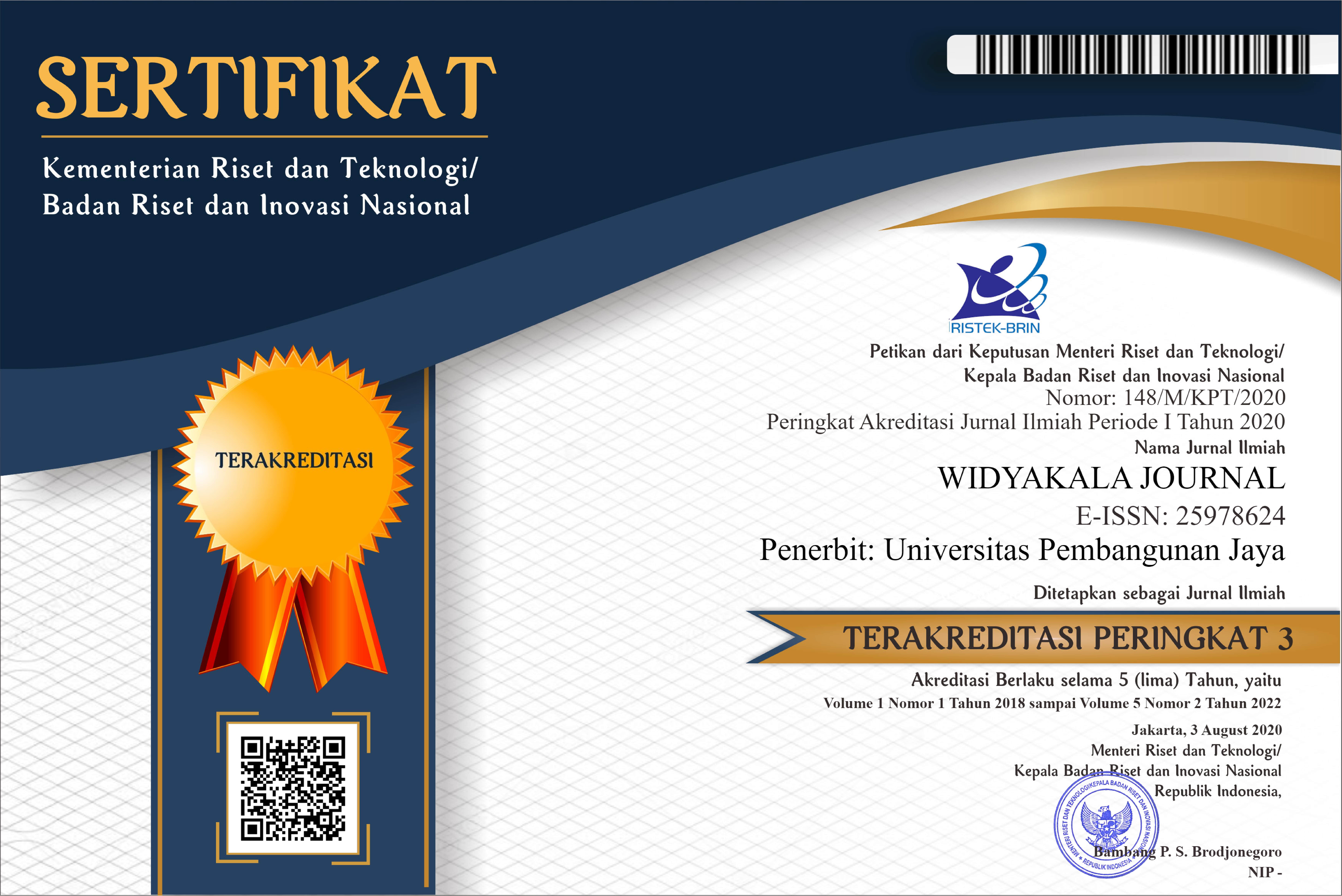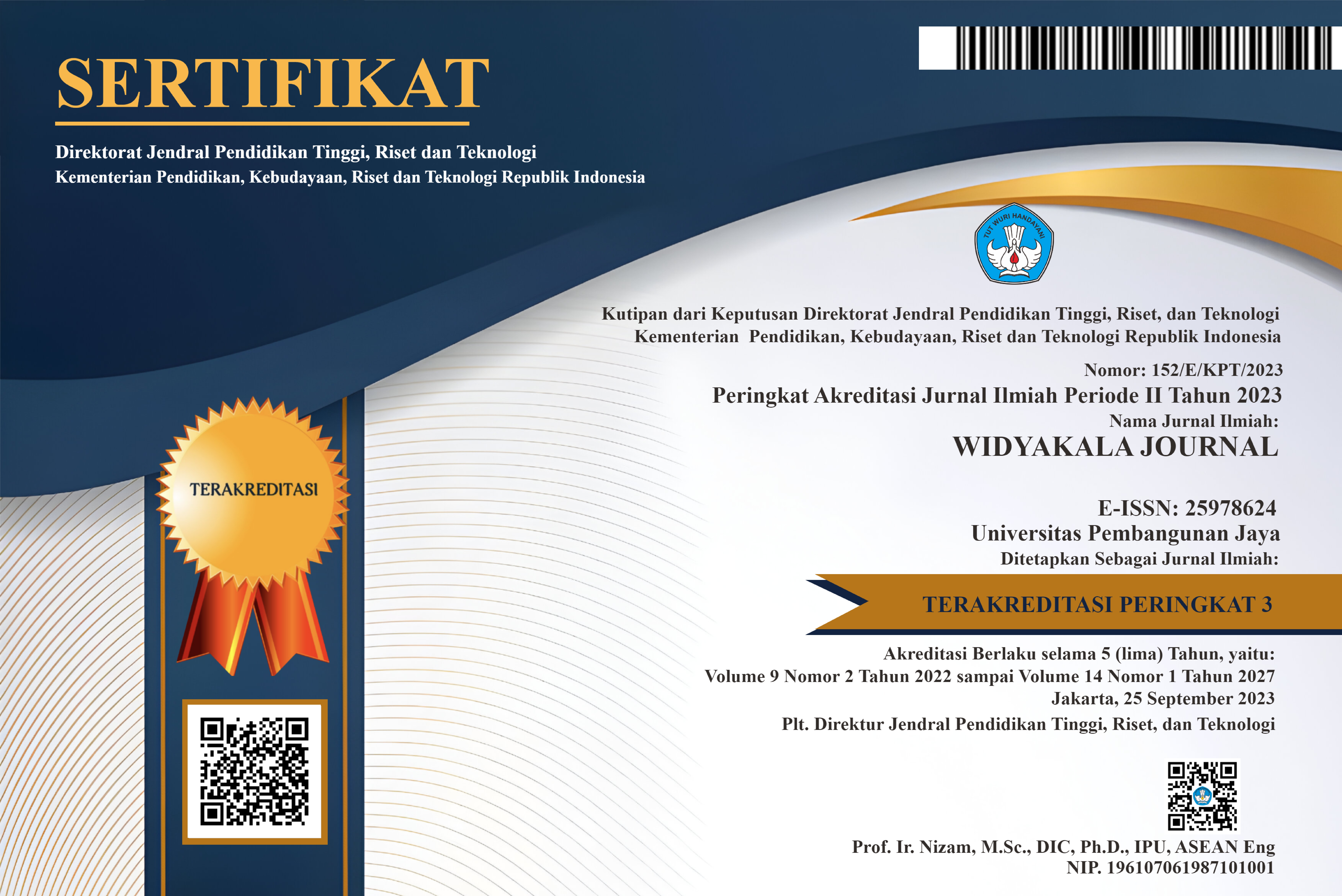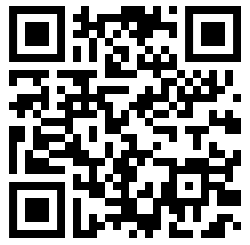Author Guidelines
Introduction
Widyakala Journal is published regularly by Universitas Pembangunan Jaya, one year twice in March and September. Widyakala's journal focuses on studies in the field of Liberal Arts, Sustainable Development and Entrepreneurship. The Widyakala Journal accepts papers related to the focus of the three studies above, which come from the results of empirical research (such as surveys, case studies, experiments, analysis, design and historical approaches), theoretical studies that aim to advance existing theories or theory adaptations to situations local, theoretical studies with the aim of reviewing and synthesizing existing theories. The journal also receives research results from science, engineering, and community service in the form of concepts, prototypes or ready products for the market. The editorial board decides that the paper to be published in Widyakala Journal has gone through a review process by reviewers appointed by the editorial board. The results of comments and suggestions from reviewers will be submitted to the author.
Paper Submission and Correspondence
Before starting the submission, create your file is MS Docx and named as Widyakala, followed by the first author name and the first word of paper title, for example, Widyakala-Ananta-Kajian. Follow the paper submission steps to completion. There are journal section "Cover Letter" and "Articles", and thick all the submission checklist. The author must read the author guidelines before going to online submission.
If the author faces problems in this submission, please contact us.
The Editor of Widyakala Journal
Lembaga Penelitian dan Pengabdian Masyarakat, Universitas Pembangunan Jaya
Jl. Cendrawasih Raya B7/P Bintaro Jaya, South Tangerang, Banten 15413
Tel.+62-21-745-5555
E-mail: widyakala.journal@upj.ac.id
Papers are typed using single spaces (Times New Roman (TNR), 10-pitch font size) in a two-column format (7.56-cm width and 8-cm spaces between columns) on A4-size paper with a margin of 2.54-cm (top, bottom, left, right). The total length of the total paper ranges from 6-16 pages (including bibliography, figures, tables, appendices and so on). Each page is numbered in sequence.
Language
The language used for writing in this journal is Bahasa Indonesia or English.
The Structure of Paper
The manuscript must be written in the following order: Title; Authors and Affiliation; Abstracts and Keywords; Main contents of the paper; Acknowledgment (if any); Bibliography; and Appendix (if any).
Title
The title must be clear, concise and reflect the contents of the paper. Titles do not exceed 12 words or exceed two lines in Indonesian, or 10 words when using English.
Abstract
The abstract does not exceed 200 words. Abstracts are presented in English and Indonesian. An abstract should consist of a problem statement (background), objective, research methods, results, and conclusion or implication. Abstracts are accompanied by three to five keywords.
The Main ContentThe main contents of the paper consist of Introduction, Literature Review, Research Methods, Results and Discussion, and Conclusions. The introduction describes the background, problem formulation, objectives and systematics of writing. The literature review includes hypothesis formulation (if any), theoretical basis, previous research (if any) used as a reference. Research methods must be clearly described, including the methods of analyzing research data that are needed (if any). Then do discussion and interpretation of results and conclude with a conclusion. A brief explanation of the main content of a paper is described below.
INTRODUCTION: Contains the background of the study, explaining the actual phenomenon of the problem studied, supported by references and previous studies that have been done. It must describe the comparison between the article and the previous studies. The introduction contains problem(s) (one focus problem is better), purpose(s) of the study, research significance, and theory used to solve the problem(s). Every resource used in the article must all be cited in the references list. Note that there is no need for subchapters in this section.
THEORY or LITERATURE REVIEW (Optional): The foundation of the theory is to find the problems and get the answer. The theoretical basis is not just a set of definitions of a term but to identify what novelty of your work. The descriptions in this chapter use relevant, strong, sharp and up-to-date references.
METHODS: consists of a variety of research characteristics, data source, data, data collection technique(s), data collection instrument(s), data collection procedure(s), and analysis method;
RESULTS AND DISCUSSION: Can be presented in a form of subchapters, and not more than three levels without numbering. Showing and explaining as well as interpretation from the main analysis directly to answer the research problem(s) and purpose(s) of the study;
CONCLUSION: The conclusion must answer the problem(s) and purpose(s) of the study. The conclusion is not in the form of a summary and not a repetition of findings and discussion.
Figure and Table
Photos, graphics, illustrations, and diagrams are categorized as "figure". All figures and tables must be placed in the main text and numbered consecutively (distinguish numbering for tables and figures). The contents of the table cannot be separated and continued on the next page. The figure used must be clear with a minimum resolution of 300 dpi.
References
The bibliography is organized according to the APA format, sorted alphabetically based on the author's last name or agency/institution/organization. The order of writing is the name of the author, year of publication, journal title or book, name of the journal or publisher. Some examples in writing of references from several sources are as follows:
Journal:
Ancrenaz, M., Dabek, L. & O’Neil, S. (2007). The costs of exclusion: Recognizing a role for local communities in biodiversity conservation. PLoS Biology, 5(11), 2443-2448. doi:10.1371/journal.pbio.0050289.
Apriliana, E. (2019). Pengaruh tipe industri, kinerja lingkungan, dan profitabilitas terhadap carbon emission disclosure. Widyakala Journal, 6(1), 84-95, doi: 10.36262/widyakala.v6i1.149.
Cadou J. M., Duigou, L., Damil, N. & Potier-Ferry, M. (2009). Convergence acceleration of iterative algorithms applications to thin shell analysis and Navier–Stokes Equations. Computational Mechanics, 43, 253-264.
Book:
Rowling, J. K. (2001). Harry Potter and the socerer's stone. London: Bloomsburg Children's.
Suparta, W. & Alhasa, K. M. (2016). Modeling of Tropospheric Delays Using ANFIS. Basel: Springer International.
Online article:
Achmat, Z. (2013). Theory of planned behavior, masihkah relevan? Diunduh dari http://zakarija.staff.umm.ac.id/files/2010/12/Theory-of-Planned-Behaviormasihkah-relevan.pdf [30 January 2016].
The University of Texas, (2017). Texas Precipitable Water Vapor From GPS, http://www.csr.utexas.edu/texas_pwv/final/gabor/gabor.html [3 October 2019].
Proceeding:
Akkaya, K., Guvenc, I., Aygun, R., Pala, N. & Kadri, A. (2015). IoT-based occupancy monitoring techniques for energy-efficient smart buildings. 2015 IEEE Wireless Communications and Networking Conference (WCNC) - Workshop - Energy Efficiency in the Internet of Things, and Internet of Things for Energy Efficiency, pp. 59-63.
Misra, P., Burke, B. P. & Pratt, M. M. (1999). GPS performance in navigation. Proceedings of the IEEE, 87(1), pp. 65-85.
The basic format for papers presented at conferences (when available online):
Gandrung, B. & Janger, T. (2010). Perpaduan seni tari Bali dan Banyuwangi untuk daya tarik wisata. Dipresentasikan di Surabaya EXPO 2018
Annual Meeting. Surabaya, 12-14 March 2010.
Thesis/dissertation:
Purnomo, G. Y. (2017. Perancangan Sistem Deteksi Banjir Dini Menggunakan Konsep Internet of Things. Skripsi. Universitas Kristen Satya Wacana.
The basic format for reports:
Reber, E. E., Michell, R. L., & Carter, C. J. (1988). Oxygen absorption in the earth’s atmosphere. Aerospace Corp., Los Angeles, CA, Tech. Rep. TR-0200 (4230-46)-3.
The basic format for patents (when available online):
Musical toothbrush with an adjustable neck and mirror by L.M.R. Brooks (1992, May 19). Patent D 326 189 [Online]. Available: NEXIS Library: LEXPAT File: DESIGN.
![]()

